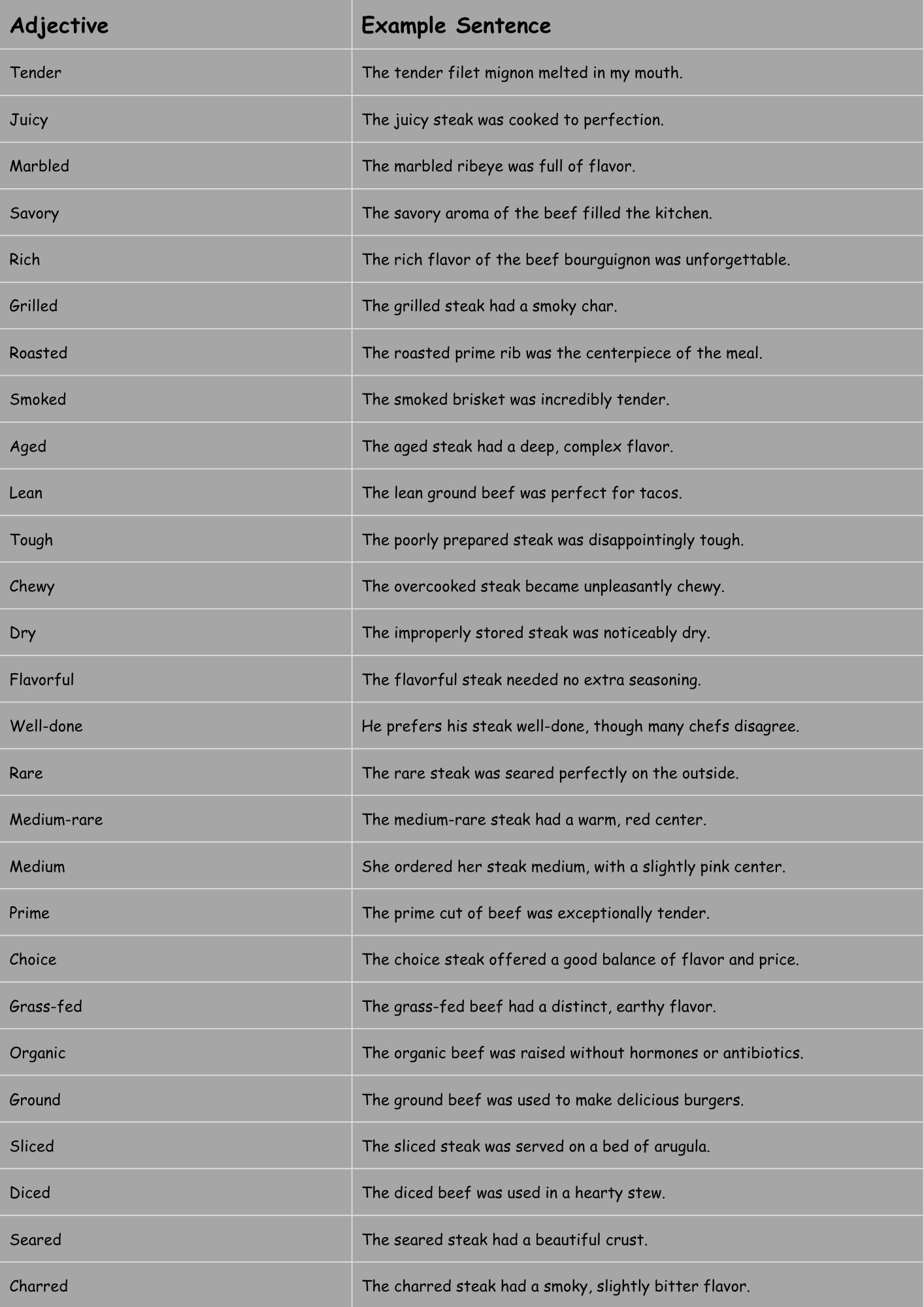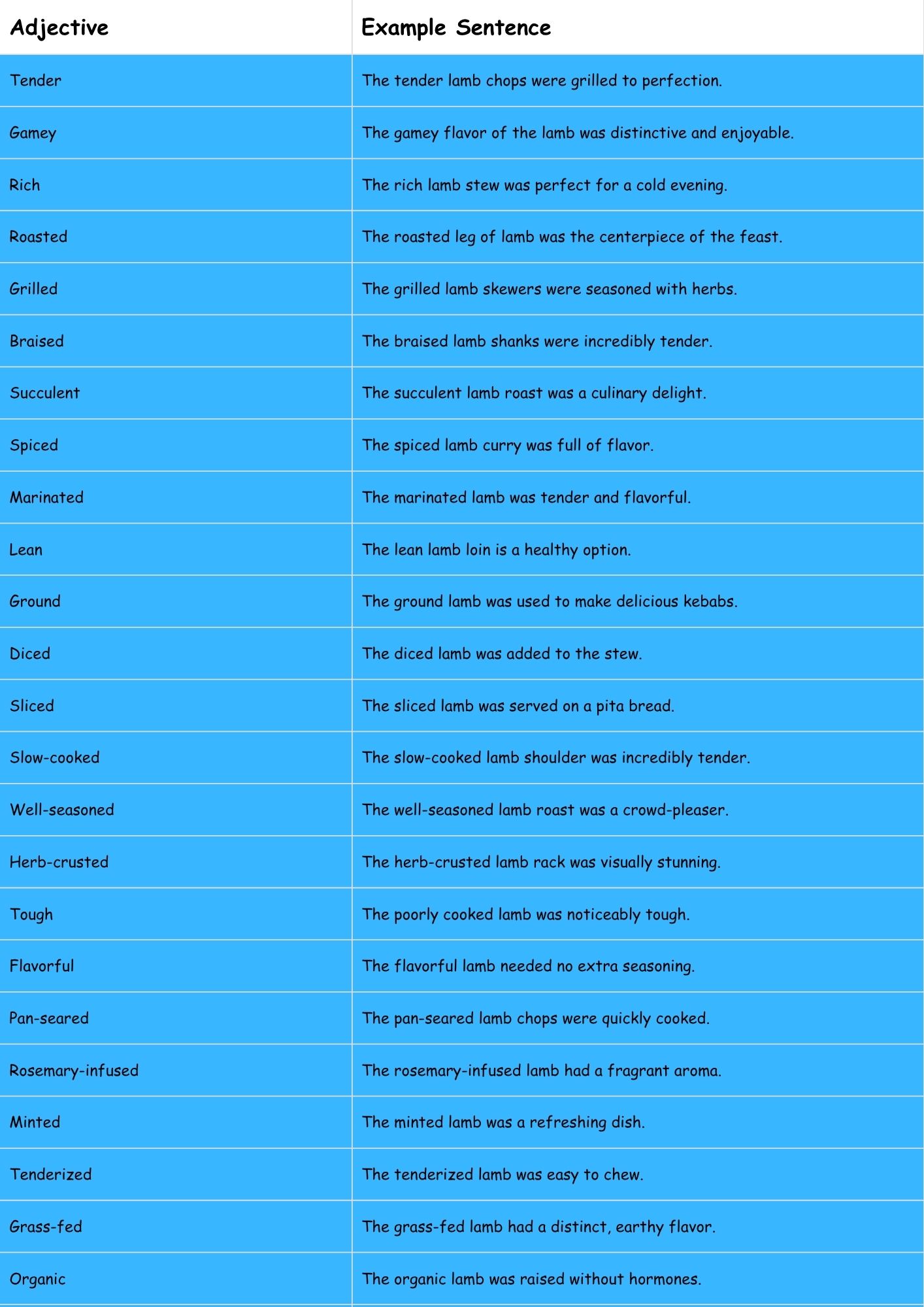Choosing the right adjectives to describe meat can elevate your culinary descriptions from bland to mouthwatering. Whether you’re a food blogger, a chef, or simply someone who enjoys talking about food, mastering the vocabulary of meat adjectives is essential. This article provides a comprehensive guide to using adjectives effectively, covering everything from basic terms to nuanced expressions that capture the essence of different meats and preparations. By understanding the nuances of these words, you can vividly convey the texture, flavor, and overall experience of enjoying meat.
This guide is designed for English language learners, food enthusiasts, and anyone looking to expand their descriptive vocabulary. We’ll explore various categories of adjectives, provide numerous examples, and offer practical exercises to help you confidently describe meat in all its delicious forms. Get ready to enhance your ability to communicate about one of the most universally enjoyed foods.
Table of Contents
- Definition of Adjectives for Meat
- Structural Breakdown
- Types of Adjectives for Meat
- Examples of Adjectives for Meat
- Usage Rules
- Common Mistakes
- Practice Exercises
- Advanced Topics
- FAQ
- Conclusion
Definition of Adjectives for Meat
Adjectives are words that describe or modify nouns. In the context of meat, adjectives are used to provide more information about its characteristics, such as its texture, flavor, appearance, preparation method, and overall quality. They help to create a more vivid and detailed picture for the reader or listener, enhancing their understanding and appreciation of the meat being described. Adjectives are crucial for clear and engaging communication about food.
The function of these adjectives is to add specificity and detail. Instead of simply saying “the steak,” you can say “the tender steak” or “the well-done steak.” These adjectives provide crucial information about the meat’s qualities. The context in which these adjectives are used is broad, spanning culinary arts, food reviews, recipes, and everyday conversations about meals. Understanding and using a wide range of adjectives for meat can significantly improve your ability to communicate effectively about food.
Structural Breakdown
The structure of adjective usage with meat nouns is relatively straightforward. Typically, the adjective precedes the noun it modifies. However, multiple adjectives can be used to describe a single noun, and their order can sometimes influence the overall meaning. Understanding the basic structure and rules for adjective order can help you construct more descriptive and accurate sentences.
The basic pattern is: Adjective + Noun. For example: juicy steak, roasted chicken, tenderloin. When using multiple adjectives, a general order is often followed, though this is not a rigid rule. A common order is: Opinion, Size, Age, Shape, Color, Origin, Material, Type, Purpose + Noun. For example, “a delicious, large, aged, round, red, Argentinian, beef, ribeye steak.” While this is a somewhat extreme example, it illustrates the general order. Commas are typically used to separate adjectives if they are coordinate (i.e., they modify the noun independently). If they are cumulative (i.e., one adjective modifies the adjective that follows), commas are not used. For example: “a delicious, tender steak” (coordinate) vs. “a dark red sauce” (cumulative).
Types of Adjectives for Meat
Adjectives for meat can be categorized based on the aspect they describe. The main categories are texture, flavor, appearance, preparation, and quality. Each category provides a different lens through which to describe the meat, allowing for a comprehensive and nuanced description.
Adjectives Describing Texture
Texture refers to the physical feel of the meat in your mouth. These adjectives describe how the meat feels when you chew it, including its tenderness, firmness, and moisture content. Texture is a crucial element of the overall eating experience.
Common texture adjectives include: tender, tough, chewy, juicy, dry, succulent, firm, soft, crumbly, smooth, stringy, fatty, lean, marbled, grainy, springy, melt-in-your-mouth, velvety, coarse, flaky.
Adjectives Describing Flavor
Flavor adjectives describe the taste of the meat. These can range from general terms like “savory” to more specific descriptions of particular flavor notes. Flavor is often the most important aspect of describing meat.
Common flavor adjectives include: savory, rich, mild, gamey, smoky, spicy, sweet, salty, tangy, earthy, umami, flavorful, bland, seasoned, marinated, grilled, roasted, fried, herby, peppery, garlicky, buttery.
Adjectives Describing Appearance
Appearance adjectives describe how the meat looks. This includes its color, shape, and overall presentation. Visual appeal can significantly influence our perception of taste.
Common appearance adjectives include: red, pink, brown, golden, charred, seared, glistening, marbled, lean, fatty, well-trimmed, rare, medium-rare, medium, medium-well, well-done, sliced, diced, ground, whole, thick, thin.
Adjectives Describing Preparation
Preparation adjectives describe how the meat was cooked or processed. This includes the cooking method, seasoning, and any other treatments it underwent. The preparation method greatly influences the final product.
Common preparation adjectives include: grilled, roasted, fried, baked, smoked, braised, stewed, cured, seasoned, marinated, spiced, breaded, stuffed, skewered, ground, sliced, diced, minced.
Adjectives Describing Quality
Quality adjectives describe the overall standard or grade of the meat. This includes factors like freshness, cut, and source. Quality is a key indicator of the meat’s overall value and desirability.
Common quality adjectives include: prime, choice, select, fresh, aged, organic, grass-fed, free-range, premium, high-quality, lean, well-marbled, tender, flavorful, authentic, artisanal.
Examples of Adjectives for Meat
The following tables provide extensive examples of adjectives used to describe various types of meat. Each table focuses on a specific type of meat and includes a range of adjectives covering texture, flavor, appearance, preparation, and quality.
The table below provides adjectives to describe beef, focusing on different cuts and preparations. It covers a range of characteristics including texture, flavor, and appearance to give you a comprehensive vocabulary.
| Adjective | Example Sentence |
|---|---|
| Tender | The tender filet mignon melted in my mouth. |
| Juicy | The juicy steak was cooked to perfection. |
| Marbled | The marbled ribeye was full of flavor. |
| Savory | The savory aroma of the beef filled the kitchen. |
| Rich | The rich flavor of the beef bourguignon was unforgettable. |
| Grilled | The grilled steak had a smoky char. |
| Roasted | The roasted prime rib was the centerpiece of the meal. |
| Smoked | The smoked brisket was incredibly tender. |
| Aged | The aged steak had a deep, complex flavor. |
| Lean | The lean ground beef was perfect for tacos. |
| Tough | The poorly prepared steak was disappointingly tough. |
| Chewy | The overcooked steak became unpleasantly chewy. |
| Dry | The improperly stored steak was noticeably dry. |
| Flavorful | The flavorful steak needed no extra seasoning. |
| Well-done | He prefers his steak well-done, though many chefs disagree. |
| Rare | The rare steak was seared perfectly on the outside. |
| Medium-rare | The medium-rare steak had a warm, red center. |
| Medium | She ordered her steak medium, with a slightly pink center. |
| Prime | The prime cut of beef was exceptionally tender. |
| Choice | The choice steak offered a good balance of flavor and price. |
| Grass-fed | The grass-fed beef had a distinct, earthy flavor. |
| Organic | The organic beef was raised without hormones or antibiotics. |
| Ground | The ground beef was used to make delicious burgers. |
| Sliced | The sliced steak was served on a bed of arugula. |
| Diced | The diced beef was used in a hearty stew. |
| Seared | The seared steak had a beautiful crust. |
| Charred | The charred steak had a smoky, slightly bitter flavor. |

This table focuses on adjectives used to describe pork, covering different cuts such as loin, ribs, and bacon. It includes adjectives related to flavor, texture, and preparation methods, offering a comprehensive vocabulary for describing pork dishes.
| Adjective | Example Sentence |
|---|---|
| Succulent | The succulent pork loin was incredibly moist. |
| Smoked | The smoked pork ribs were fall-off-the-bone tender. |
| Crispy | The crispy bacon added a perfect crunch to the sandwich. |
| Sweet | The sweet glaze on the ham was delicious. |
| Salty | The salty bacon was the perfect breakfast treat. |
| Tender | The tender pork shoulder was slow-cooked for hours. |
| Juicy | The juicy pork chops were a family favorite. |
| Roasted | The roasted pork belly had a crispy skin. |
| Cured | The cured ham was perfect for sandwiches. |
| Spiced | The spiced pork tenderloin was full of flavor. |
| Fatty | The fatty pork belly is prized for its rich flavor. |
| Lean | The lean pork tenderloin is a healthy option. |
| Mild | The mild flavor of the pork allows it to pair well with many sauces. |
| Braised | The braised pork was incredibly tender and flavorful. |
| Pulled | The pulled pork was perfect for sandwiches and tacos. |
| Ground | The ground pork was used to make delicious dumplings. |
| Diced | The diced pork was added to the stir-fry. |
| Sliced | The sliced ham was served on a platter. |
| Caramelized | The caramelized pork belly was a culinary masterpiece. |
| Smoky | The smoky flavor of the pulled pork was irresistible. |
| Crisp | The crisp bacon crumbled perfectly over the salad. |
| Well-seasoned | The well-seasoned pork roast filled the house with an inviting aroma. |
| Marinated | The marinated pork was tender and bursting with flavor. |
| Slow-cooked | The slow-cooked pork shoulder was incredibly tender. |
| Pan-fried | The pan-fried pork chops were golden brown and juicy. |
This table provides adjectives to describe poultry, focusing on chicken, turkey, and duck. It includes terms related to texture, flavor, appearance, and preparation, providing a comprehensive vocabulary for discussing poultry dishes.
| Adjective | Example Sentence |
|---|---|
| Tender | The tender chicken breast was easy to cut. |
| Juicy | The juicy turkey was a hit at Thanksgiving. |
| Crispy | The crispy skin of the roasted chicken was delicious. |
| Savory | The savory aroma of the chicken filled the house. |
| Roasted | The roasted duck was served with a cherry sauce. |
| Grilled | The grilled chicken was perfect for a summer barbecue. |
| Smoked | The smoked turkey had a rich, complex flavor. |
| Fried | The fried chicken was crispy and golden brown. |
| Lean | The lean chicken breast is a healthy source of protein. |
| Gamey | The gamey flavor of the duck was distinctive. |
| Succulent | The succulent turkey leg was a Thanksgiving favorite. |
| Seasoned | The seasoned chicken was perfectly spiced. |
| Herb-roasted | The herb-roasted chicken had a fragrant aroma. |
| Stuffed | The stuffed turkey was filled with savory breadcrumbs. |
| Braised | The braised chicken was tender and flavorful. |
| Ground | The ground turkey was used to make healthy burgers. |
| Diced | The diced chicken was added to the stir-fry. |
| Sliced | The sliced turkey was served on a platter. |
| Golden-brown | The golden-brown chicken looked incredibly appetizing. |
| Well-seasoned | The well-seasoned chicken thighs were bursting with flavor. |
| Marinated | The marinated chicken was tender and juicy. |
| Free-range | The free-range chicken had a richer flavor. |
| Organic | The organic chicken was raised without antibiotics. |
| Pan-fried | The pan-fried chicken cutlets were quick and easy to prepare. |
This table provides adjectives to describe lamb and mutton, focusing on different cuts and preparations. It includes adjectives related to flavor, texture, and appearance, providing a comprehensive vocabulary for discussing lamb dishes.
| Adjective | Example Sentence |
|---|---|
| Tender | The tender lamb chops were grilled to perfection. |
| Gamey | The gamey flavor of the lamb was distinctive and enjoyable. |
| Rich | The rich lamb stew was perfect for a cold evening. |
| Roasted | The roasted leg of lamb was the centerpiece of the feast. |
| Grilled | The grilled lamb skewers were seasoned with herbs. |
| Braised | The braised lamb shanks were incredibly tender. |
| Succulent | The succulent lamb roast was a culinary delight. |
| Spiced | The spiced lamb curry was full of flavor. |
| Marinated | The marinated lamb was tender and flavorful. |
| Lean | The lean lamb loin is a healthy option. |
| Ground | The ground lamb was used to make delicious kebabs. |
| Diced | The diced lamb was added to the stew. |
| Sliced | The sliced lamb was served on a pita bread. |
| Slow-cooked | The slow-cooked lamb shoulder was incredibly tender. |
| Well-seasoned | The well-seasoned lamb roast was a crowd-pleaser. |
| Herb-crusted | The herb-crusted lamb rack was visually stunning. |
| Tough | The poorly cooked lamb was noticeably tough. |
| Flavorful | The flavorful lamb needed no extra seasoning. |
| Pan-seared | The pan-seared lamb chops were quickly cooked. |
| Rosemary-infused | The rosemary-infused lamb had a fragrant aroma. |
| Minted | The minted lamb was a refreshing dish. |
| Tenderized | The tenderized lamb was easy to chew. |
| Grass-fed | The grass-fed lamb had a distinct, earthy flavor. |
| Organic | The organic lamb was raised without hormones. |

This table focuses on adjectives used to describe venison (deer meat), covering different cuts and preparations. It includes adjectives related to flavor, texture, and preparation methods, offering a comprehensive vocabulary for describing venison dishes.
| Adjective | Example Sentence |
|---|---|
| Gamey | The gamey flavor of the venison was pronounced and earthy. |
| Lean | The lean venison loin is a healthy choice. |
| Tender | The tender venison steak was cooked to medium-rare. |
| Rich | The rich venison stew was perfect for a winter evening. |
| Roasted | The roasted venison haunch was a festive dish. |
| Grilled | The grilled venison burgers were a hit at the barbecue. |
| Smoked | The smoked venison sausage had a deep, complex flavor. |
| Braised | The braised venison shanks were incredibly tender. |
| Seasoned | The seasoned venison was spiced with juniper berries. |
| Marinated | The marinated venison was tender and flavorful. |
| Earthy | The earthy flavor of the venison paired well with mushrooms. |
| Wild | The wild venison had a distinct, natural taste. |
| Ground | The ground venison was used to make chili. |
| Diced | The diced venison was added to the stew. |
| Sliced | The sliced venison was served with a red wine reduction. |
| Slow-cooked | The slow-cooked venison was incredibly tender. |
| Well-seasoned | The well-seasoned venison roast was a crowd-pleaser. |
| Herb-crusted | The herb-crusted venison rack was visually stunning. |
| Seared | The seared venison medallions were cooked to perfection. |
| Juniper-infused | The juniper-infused venison had a fragrant aroma. |
| Tough | The poorly prepared venison was noticeably tough. |
| Dry | The overcooked venison was unpleasantly dry. |
Usage Rules
Using adjectives correctly involves understanding their placement in a sentence, their agreement with the nouns they modify, and the order in which multiple adjectives should be used. Misusing adjectives can lead to confusion or awkward phrasing.
Adjective Placement: Typically, adjectives precede the noun they modify. For example: “the tender steak.” However, adjectives can also follow a linking verb (such as is, are, was, were, seems, appears, becomes). For example: “The steak is tender.”
Adjective Agreement: In English, adjectives do not change form to agree with the noun’s number or gender (unlike some other languages). The adjective remains the same regardless of whether the noun is singular or plural. For example: “a juicy steak,” “juicy steaks.”
Order of Adjectives: When using multiple adjectives, there is a general order to follow, although it’s not a strict rule. The typical order is: Opinion, Size, Age, Shape, Color, Origin, Material, Type, Purpose. For example: “a delicious, large, aged, round, red, Argentinian, beef, ribeye steak.” Using this order generally sounds more natural to native English speakers.
Coordinate vs. Cumulative Adjectives: Coordinate adjectives independently modify the noun and are separated by commas. Cumulative adjectives build upon each other, with one modifying the adjective that follows, and are not separated by commas. For example: “a delicious, tender steak” (coordinate) vs. “a dark red sauce” (cumulative).
Common Mistakes
Several common mistakes can occur when using adjectives for meat, including incorrect adjective order, using adjectives that don’t accurately describe the meat, and misusing comparative and superlative forms.
| Mistake | Incorrect Example | Correct Example |
|---|---|---|
| Incorrect Adjective Order | The steak red delicious. | The delicious red steak. |
| Inaccurate Adjective | The steak was soft. (when it was tough) | The steak was tough. |
| Misusing Comparative/Superlative | This steak is more tastier than that one. | This steak is tastier than that one. |
| Using an Adverb Instead of an Adjective | The meat was deliciously. | The meat was delicious. |
| Redundant Adjectives | The juicy, succulent steak. | The juicy steak. (or The succulent steak.) |
Practice Exercises
Test your knowledge with these practice exercises. Each question requires you to choose the best adjective to describe the meat in the given context. Answers are provided below.
Exercise 1: Choose the best adjective to complete each sentence.
| Question | Options | Answer |
|---|---|---|
| 1. The ______ steak was perfectly cooked and melted in my mouth. | a) tough b) tender c) chewy | b) tender |
| 2. The ______ bacon added a perfect crunch to the breakfast. | a) soggy b) crispy c) soft | b) crispy |
| 3. The ______ chicken had a rich, smoky flavor. | a) boiled b) grilled c) smoked | c) smoked |
| 4. The ______ lamb was seasoned with herbs and spices. | a) bland b) spiced c) tasteless | b) spiced |
| 5. The ______ venison stew was perfect for a cold winter evening. | a) cold b) warm c) rich | c) rich |
| 6. The ______ pork chops were juicy and flavorful. | a) dry b) overcooked c) succulent | c) succulent |
| 7. The ______ turkey was the centerpiece of the Thanksgiving dinner. | a) small b) large c) roasted | c) roasted |
| 8. The ______ beef was aged to perfection. | a) new b) fresh c) aged | c) aged |
| 9. The ______ duck had a distinctive, gamey flavor. | a) mild b) gamey c) plain | b) gamey |
| 10. The ______ ham was perfect for sandwiches. | a) cured b) raw c) uncooked | a) cured |
Exercise 2: Rewrite the following sentences using more descriptive adjectives.
- The steak was good.
- The chicken was cooked.
- The pork was tasty.
- The lamb was nice.
- The beef was okay.
- The turkey was fine.
- The bacon was interesting.
- The venison was edible.
- The ham was acceptable.
- The meat was prepared.
Possible Answers for Exercise 2:
- The tender steak was perfectly seasoned and melted in my mouth.
- The roasted chicken had a crispy skin and was incredibly juicy.
- The savory pork was seasoned with garlic and herbs, making it incredibly tasty.
- The succulent lamb chops were grilled to perfection and had a gamey flavor.
- The well-marbled beef ribeye was rich and flavorful.
- The smoked turkey was the centerpiece of the Thanksgiving dinner, with a tender and juicy texture.
- The crispy bacon added a salty and smoky flavor to the breakfast.
- The lean venison stew was hearty and earthy, perfect for a cold evening.
- The cured ham was sliced thinly and served on a platter, with a salty and sweet taste.
- The meat was braised for hours, resulting in a tender and flavorful dish.
Advanced Topics
For advanced learners, understanding the nuances of adjective usage and exploring more sophisticated vocabulary can significantly enhance their descriptive abilities. This includes delving into figurative language, idiomatic expressions, and regional variations in meat terminology.
Figurative Language: Using metaphors and similes can create vivid and memorable descriptions. For example, instead of saying “the steak was very tender,” you could say “the steak was as tender as butter.” This adds a layer of imagery and emotional impact to your description.
Idiomatic Expressions: Certain idiomatic expressions are commonly used to describe meat. For example, “fall-off-the-bone tender” is a common way to describe ribs or other slow-cooked meats. Understanding and using these expressions can make your descriptions sound more natural and engaging.
Regional Variations: Meat terminology can vary significantly by region. For example, what is called “brisket” in the United States might be referred to by a different name in another country. Being aware of these regional differences can help you communicate more effectively with diverse audiences.
FAQ
Here are some frequently asked questions about using adjectives for meat, along with detailed answers:
- What is the best way to learn new adjectives for meat?The best way to learn new adjectives is through exposure and practice. Read food blogs, watch cooking shows, and pay attention to how chefs and food writers describe meat. Make a list of new adjectives you encounter and try using them in your own descriptions. Flashcards and vocabulary apps can also be helpful tools.
- How can I avoid using the same adjectives repeatedly?To avoid repetition, focus on expanding your vocabulary by using a thesaurus to find synonyms for commonly used adjectives. Try to be more specific in your descriptions by focusing on particular aspects of the meat, such as its texture, flavor, or appearance. For example, instead of always saying “tender,” try “melt-in-your-mouth” or “velvety.”
- Is it okay to use subjective adjectives when describing meat?Yes, subjective adjectives (such as “delicious” or “amazing”) are perfectly acceptable, especially in personal reviews or informal conversations. However, it’s also important to provide objective descriptions (such as “tender” or “smoky”) to give your audience a more complete picture of the meat’s qualities.
- How important is adjective order when describing meat?Adjective order is important for creating natural-sounding sentences. While it’s not a rigid rule, following the general order (Opinion, Size, Age, Shape, Color, Origin, Material, Type, Purpose) can help your descriptions flow more smoothly. However, don’t be afraid to deviate from the order if it sounds more natural in a particular context.
- Can I use too many adjectives in a single sentence?Yes, using too many adjectives can make your writing sound cluttered and awkward. It’s best to choose a few key adjectives that accurately and effectively convey the meat’s qualities. Focus on quality over quantity, and make sure each adjective adds value to the description.
- How do I describe meat that I don’t like?When describing meat you don’t like, be honest but also respectful. Instead of simply saying “it was bad,” try to be specific about what you didn’t like. For example, “The meat was tough and dry,” or “The flavor was too gamey for my taste.” This provides constructive feedback without being overly negative.
- Are there any adjectives I should avoid using when describing meat?Avoid using adjectives that are vague or uninformative, such as “good,” “okay,” or “fine.” These adjectives don’t provide any specific information about the meat’s qualities. Also, avoid using offensive or insensitive language.
- How can I improve my descriptive writing skills in general?To improve your descriptive writing skills, practice regularly and seek feedback from others. Read widely and pay attention to how skilled writers use adjectives and other descriptive language. Experiment with different techniques
and try to incorporate sensory details into your writing. The more you practice, the better you’ll become at crafting vivid and engaging descriptions.
Conclusion
Mastering the use of adjectives for meat can significantly enhance your ability to communicate about food. By understanding the different types of adjectives, following usage rules, avoiding common mistakes, and practicing regularly, you can craft vivid and engaging descriptions that capture the essence of various meats and preparations. Whether you’re a food blogger, a chef, or simply someone who enjoys talking about food, a strong command of meat adjectives is an invaluable asset.
Continue to expand your vocabulary, experiment with different descriptive techniques, and seek feedback from others to further refine your skills. With practice and dedication, you can become a master of descriptive writing and elevate your culinary communications to new heights. Happy describing!



